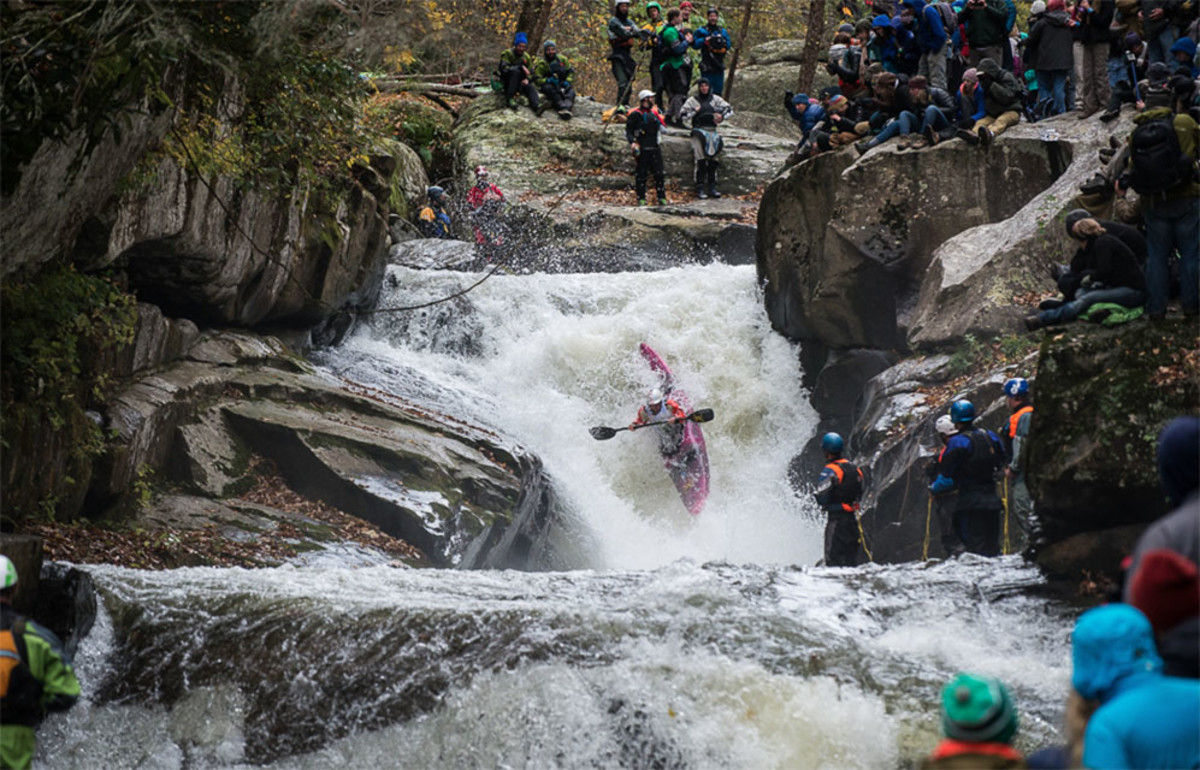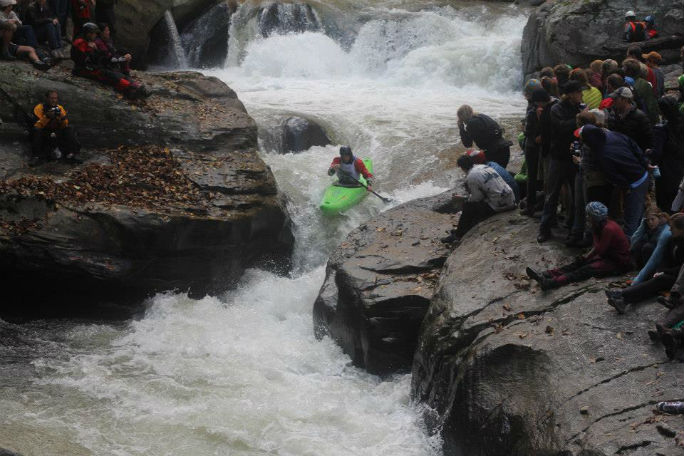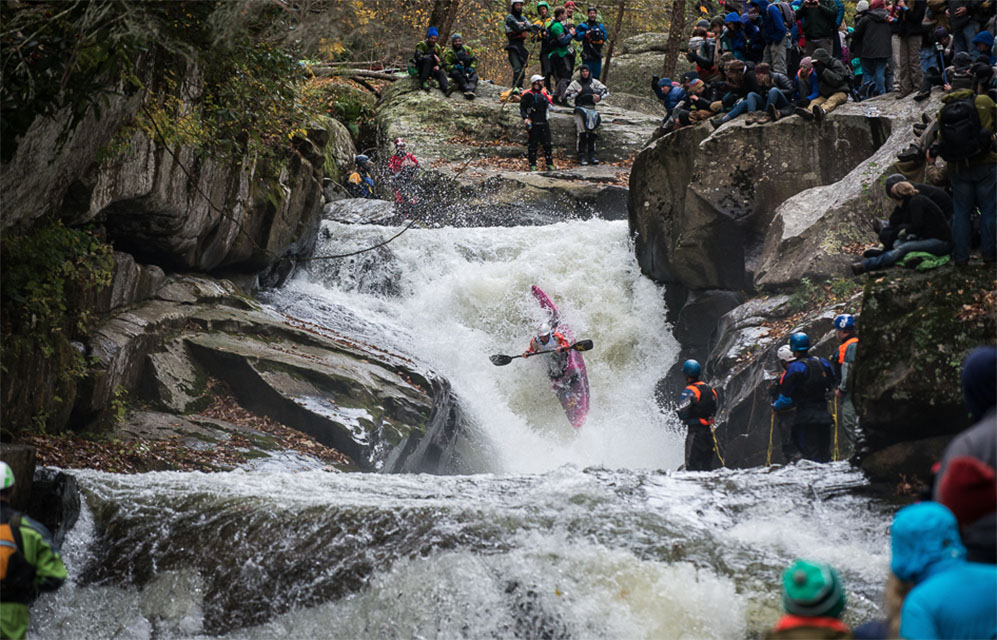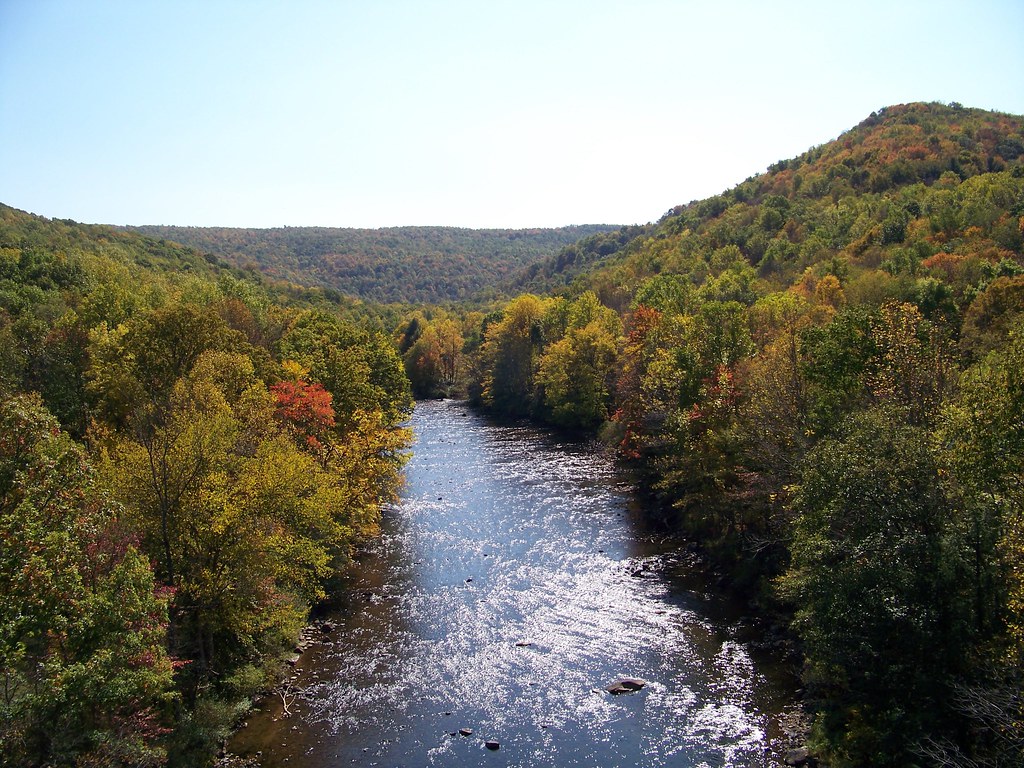
I know I’m about two weeks late posting about this, but I love Green Race kayaking footage.
In fact, just about the only thing in November I welcome is my Facebook feed filling with Green Race videos. The most famous kayak extreme race in the United States is held every November — something they can do in Asheville because it’s actually a reasonable temperature . . . unlike here in New Hampshire, where any geese who haven’t flown south yet basically freeze in place like lawn ornaments.
This year my favorite Green Race footage was a four-way split screen of the top four finishers’ GoPro footage. It’s Eric Deguil, Pat Keller, Dane Jackson, and Colin Hunt — four world-class athletes running the Green Narrows faster than it usually takes me to execute the portage at Gorilla.
There were also some spectacular crash videos. Bobby Miller posted video of him swimming out of the big Scream Machine hole and then down the next rapid, while Tad Dennis — a C-1 friend — earned my everlasting admiration by not only racing the Green in a kayak, but by posting a training video of him breaking a kayak paddle — and then running Gorilla anyway with half a blade!!
While it was fun to make about 45 armchair descents of the Narrows over the last few weeks, it did get me thinking: How the hell did we ever survive before GoPro footage?
And how — now that we have it — has GoPro footage changed kayaking?
***
Back when I started paddling, the boating videos we watched were heavily edited. Of course they were — they were commercially produced, made to sell. The only Green Race footage we had was three months after the race in some well-filmed but deeply edited LVM segment. They only had a few cameras in a few places, so you tended to get short clips of Tommy Hilleke and Jason Hale dropping off Gorilla, or quick cuts of ten straight guys getting “yeasted” at Go Left and Die. But nowadays, removed from the pressure of having to sell the footage, and with uploading an entire video being so easy, GoPro users tend to post longer, less-edited clips — often uninterrupted race runs (something unthinkably boring in the age before the internet). Some of them don’t even have music. On the whole, these GoPro videos are, for lack of a better term, more “honest.”
And here’s the thing: a lot of the GoPro you tend to see comes not from good runs but from bad. For every blazingly fast Eric Deguil run, there’s a Rush Sturges carnage clip. I’ve watched some of the most harrowing beatings, swims, and rescues during the GoPro era. It really has become this whole confessional genre — the proverbial black box footage from the cockpit: “Here’s what went wrong — and here’s how to avoid what I did.” Compared to the old method kayakers had of accident analysis — posting written narratives — GoPro footage is not only more informative, but I think somewhat less prone to spark online name calling and controversy, largely because it’s so matter-of-fact about what happened.
That’s what’s great about user-posted GoPro: compared to traditional, edited video, it’s incredibly honest. Sometimes you learn how to do Go Left in three strokes, and other times you learn what happens when you don’t get far enough left at Go Left.

And here’s another benefit of GoPro footage: it’s a great way to learn new rivers. Say you’re going to the Raven Fork tomorrow morning. You can spend your whole evening sucking down a few IPAs and watching one of fifty-odd easily-findable Raven Fork GoPro videos on YouTube. Then you have a cockpit view as boaters of various competencies escort you down Mike Tyson’s and Headless Horseman. It’s like getting to do a trial run without the danger.
Back when I started boating, most of the best rivers weren’t even in the guidebook. If we wanted to know what a run was like, we sucked down a few beers, then called (not texted — called) someone who’d run it before and tried to play it off nonchalantly like we were “just curious” (read: terrified). Or — if we were lucky — we watched some grainy DVD or even VHS footage shot from shore featuring four second clips of guys in Corsicas running rapids that could have been anywhere on the river. Nowadays GoPro footage is so high-quality, you feel like you’ve already run the river by the time you actually pull into an eddy above the big drop. That’s got to be a good thing, right?
Lastly, we all know that one of the best parts about boating is reliving your runs. Back when I started, we did that through these things called “still pictures” or even “memory.” Or if we wanted to capture mediocre video, we actually had to lug around a camera in a drybag, get out on shore, make our buddies wait for us, then get back in our boats. It was cumbersome.
Today? Taking and posting GoPro is so easy that you practically get home and you can find footage from your run already up online. You can relive that run of the Upper Blackwater almost instantly. Plus, it’s not only going to live on in your own mind, or in the minds of one or two buddies who were there. Now it’s easier than ever for you to share with your wider social media audience just what a daring, awesome person you are, or what it’s truly like down in the Grand Canyon.
Between the beautiful footage and the ease of sharing, their slogan really couldn’t be truer: “GoPro — be a hero.”

***
And yet — there’s something lost in all that sharing.
For one thing, doesn’t GoPro kill the mystique? I know, I know — you’re thinking, “Come on! More paddling videos = always better.” But hear me out.
Let’s say you’re an aspiring class V paddler hoping to make a personal first descent down a benchmark local run, like the Middlebury Gorge in Vermont. Back in 2003, when I first ran it, there was zero video of it findable anywhere, and maybe a handful of still shots on the old American Whitewater page. You had a droll, ten-word description in Greg Hanlon’s guidebook, but really if you wanted info, you basically had to buttonhole a local paddler at the takeout. I used to do this a lot. I was like Lyndon Johnson about to corner some poor junior senator. It was either that or you just selected your most trusted guide and lasered in on his stern. Because you hadn’t seen any of the rapids before, once you got into the gorge, it was all pretty mind-blowing.
Of course you can still do that, but I honestly wonder how many people do? Don’t you think it would take a concerted effort NOT to look up a new run ahead of time on YouTube? Sure, lots of rivers aren’t up on YouTube, but lots of them are, right? Especially the good ones. When I first published my river guidebook in 2008, I used to worry that I was ruining the sense of adventure for everyone because I was writing short descriptions and publishing maps and photos. How quaint! Isn’t the power to watch everything ahead of time now a pretty fundamental shift from just 15 years ago?
Back then, if anything, your first run was actually enhanced by the forbidding stories you’d heard. And that brings up another thing I think is sort of lost in the GoPro era: the power of storytelling. Ours is a sport with a pretty healthy tradition of tall tales, war stories, exaggeration, and bar-room bragging. It’s great. It’s our oral tradition, a time-honored way that boaters have bonded and also passed along important information: “No shit there I was . . .” What’s more fun than sitting around at the take out with your buddies swapping tales of how brave you all were?
Here’s the thing about GoPro — it doesn’t kill off the oral tradition, but doesn’t it kind of negate its power? The more we film, the less reason we have to pass on these stories orally or in writing. Like I said before, GoPro is nothing if not honest. That boof you did years ago off that waterfall — the boof you’ve always been talking about? The one that got bigger and bigger over the years? How much do you want to bet that if you had GoPro footage of it, you’d discover it wasn’t nearly as big as you’re remembering it?
How many times have you seen someone post video of what they called an “epic” swim — only to see the GoPro and find out it was surprisingly short — maybe ten or twelve seconds?
And that really hard, really steep run you just ran at high flows? Doesn’t look so bad on GoPro. Looks sort of like class III!
It’s especially misleading if you sit up high in C-1 and have a long torso, so your GoPro is like eight feet out of the water. On me the Upper Blackwater looks like the Potomac in Georgetown. My point is that the same honesty that makes GoPro footage such a great teaching tool also drains some of the power from the usual lore and myth-making in our sport. Yeah, it’s great to have a clearer picture of what the Niagara Gorge looks like in a boat, but wasn’t it sort of better when you only heard second hand that the waves were so tall, in Chris Koll’s words, you couldn’t even tell the color of the sky? “Read my words well and don’t be a fool: the Alsek is unpaddleable!” wrote Walt Blackadar in his seminal 1971 Sports Illustrated article about running Turnback Canyon of the Alsek. Would this electrifying account have been dulled just a little bit if we’d had GoPro footage of Blackadar flailing his way down some muddy-looking waves in a 13-foot boat?
Plus, can’t I just ask — don’t we go to nature to get away from an increasingly invasive world of cameras and surveillance? Isn’t it sort of weird to think about everything you do being recorded because some guy in your group is running his GoPro? Believe me, I’ve been that guy, but isn’t that sort of an invasion of privacy when you think about it?
Sure it’s fun to relive your kayaking videos, but isn’t it somehow more special if you have to relive it in memory — if the only people who really know about it were the people who were there? Doesn’t that create a more memorable bond?
There’s a lot that’s been written in the last few years about how our experiences are becoming less about nourishing our souls than about becoming a show for others. Nature becomes “content” rather than something to be enjoyed. We live for the future moment (when we’ll post on social media) rather than for the present.
Isn’t there something lost when our crashes and our victories are all recorded, plainly, and posted the next day on social media — rather than lionized in tall tales and epic stories told for years around the campfires? Surely to some extent you can have both, but it doesn’t have the same ring to it. Instead of “No shit, there I was,” now it’s, “Yeah, it’s on my Facebook page.”









